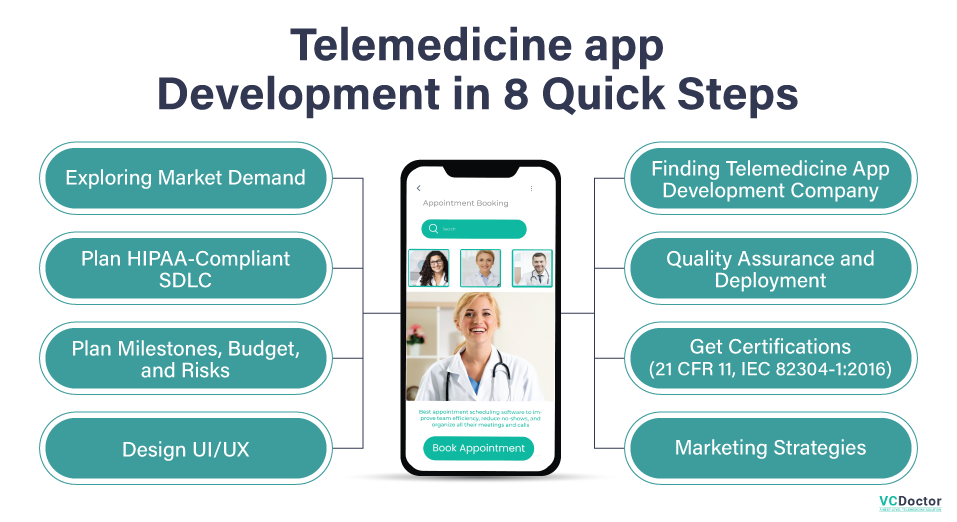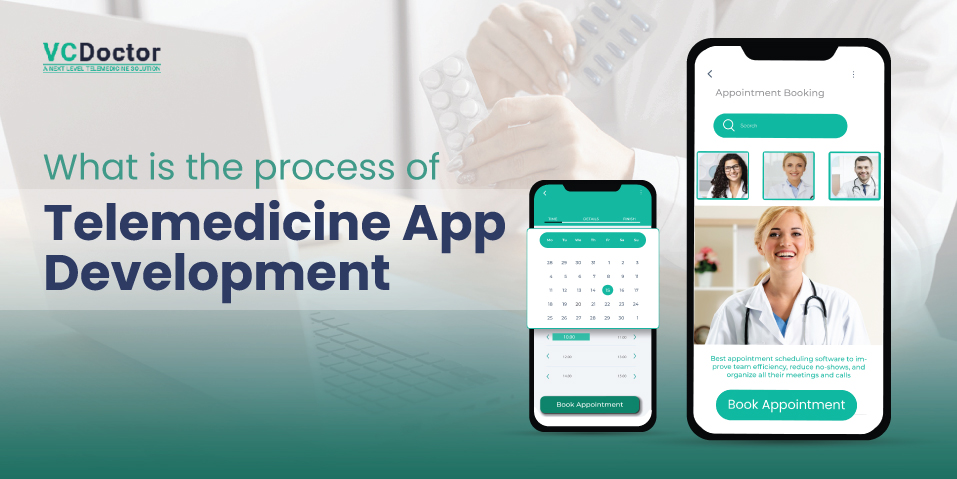What is the process of Telemedicine app Development
Telemedicine applications are growing quickly. Although they are transforming healthcare delivery systems dramatically. Thus, such digital platforms provide patients with an outstanding level of comfort and flexibility regarding obtaining medical consultations. However, the possibilities of obtaining advantages by patients and doctors are indisputable to create an effective telehealth application, it is required to have a clear vision of a strategy. Explore the complete information about how to develop a healthcare app for the healthcare professional or an entrepreneur. Learn the complete process of designing, building, and implementing a telemedicine app development that is secure and, by the same token, client-centered right from the moment the idea germinates in the mind of the innovator.
Demand of Telemedicine App
There is huge demand for telemedicine app for doctors in the current healthcare market. It means that more and more people will adopt applications to consult doctors from the comfort of their own homes. First, telemedicine apps are convenient. You do not need to sit in congested waiting rooms or take time off work to get to an appointment. Second, they can be less expensive than typical doctor appointments. Overall the COVID-19 pandemic brought a huge revolution in virtual healthcare and demand for telehealth app developers. Even though things are returning to normal, it appears that telemedicine applications are here to stay.
Understand Telemedicine app development in 8 Quick steps

Exploring Market Demand
First and the foremost step of telemedicine app development solutions is understanding the market demand. It is very important to understand what patients and professionals actually need. So when you get an idea of the majority of people seeking particular telemedicine support, then you can develop the app of their choice. It will help you get the insight which telemedicine platform people mostly use and what are the approaches they made to engage the customers.
Additionally, it is also necessary to understand the market because when you deploy an app on the global platform it must contain all the features that are essential for the public. Moreover Assessing market demand helps estimate adoption rates and revenue. It informs budgeting and resource allocation. Engaging with healthcare professionals, patients, and experts provides valuable feedback. This ensures the app meets real-world needs. Exploring market demand reduces the risk of developing an app that fails to attract users or address critical issues.
Plan HIPAA-Compliant SDLC
The software development life cycle (SDLC) used for the telemedicine app should adhere to the HIPAA norms. It encompasses protection of data, data encryption while storing and processing as well as the security checks for deficiencies. Define each phase of the SDLC: as planning, design, development, testing, deployment, maintenance, and many more. HIPAA compliance should also be considered in every of the steps. Telemedicine app developer must be trained on HIPAA requirements, and there should be compliance checks from time to time while documentation should be comprehensive. Incorporation on the other hand ensures HIPAA compliance that enhances the protection of patients’ data and meets set standards within the software development life cycle. This minimizes the prospects of a break and legal matters which may prove costly.
Plan Milestones, Budget, and Risks
Project planning is an understated yet critical element that has to be implemented in telemedicine app development services. To develop an initial plan for each phase of the project, draw a timeline diagram and specify the major milestones of each stage from the planning to the deployment phase. Determine the costs, including developmental, licensing, promotional, and sustaining costs that would be equated to the software. Look into potential threats, like technological or changes in the laws, or market threat, and come up with measures to handle them. Continuously run a check on the plan and make changes where needed based on emerging problems or new occurrences. If planning is well done then it guarantees that the project would follow the laid down schedules, costs within the estimated amount, and meets all the needed standards before delivery without a possibility of incurring additional costs along the way.
Design UI/UX
The user interface (UI) design should cater to the specific needs of both patients and doctors. Telehealth app development for patients, prioritize ease of use, accessibility, and a friendly, intuitive design. Features like appointment scheduling, video consultations, and prescription management should be easy to navigate. For doctors, the UI should focus on functionality, quick access to patient records, and efficient workflow management. This includes features like patient data visualization, secure messaging, and integration with Electronic Health Records (EHR). Conduct usability testing with real users to gather feedback and make necessary adjustments. A well-designed UI enhances user satisfaction and engagement, leading to better healthcare outcomes.
Finding Telemedicine App Development Company
To select a proper telehealth app development company, several tasks must be done. First, find telemedicine experienced companies and list them. It is also recommended to look at their works as displayed in their portfolios. One can even read some service’s reviews and testimonials to know its popularity among clients. Make sure they know about HIPAA and other rules that apply to healthcare organizations. Assess its comprehensiveness of communication techniques used and learners’ responses to various situations. Inquire about your development process, your timetable and your supporting facilities. Last of all, selecting a particular firm from the mentioned above criteria is the perfect combination between experience, expertise, and cost. It ensures that you get a good partner in the development of your telemedicine app since the selection process is well done.
Quality Assurance and Deployment
Factors to consider while deployment and assuring quality of the product with telemedicine app developers.
Quality Assurance:
- Testing: Find and fix bugs through detailed testing.
- User Feedback: Collect feedback from beta testers to improve the app.
- Compliance Check: Ensure the app follows HIPAA and other regulations.
- Documentation: Keep detailed records of testing and results.
Deployment:
- Preparation: Set up servers, databases, and needed infrastructure. Make sure they are secure.
- Launch: Release the app on platforms like the App Store and Google Play.
- Monitoring: Continuously check the app for performance issues and user feedback.
- Updates: Regularly update the app to fix bugs, add features, and maintain compliance.
Get Certifications (21 CFR 11, IEC 82304-1:2016)
Gaining the right certifications is crucial in order to guarantee you have a safe, high quality, and compliant telehealth application. The regulatory guide of 21 CFR 11 is centered specifically on electronic records and electronic signatures and guarantees that they can be trusted as reliable as paper-based equipment. This is applicable in protecting the patient data consistency and security from malicious attack or corruption. The standard name of this certification is IEC 82304-1:2016 and it concerns health software meaning that the app must possess the necessary quality and safety that are required in this particular field. These certifications add value to your telehealth software development and make them appealing to the healthcare providers and patients in the use of the gadgets. Further, it is crucial to keep up with current legal requirements and adhere to them by practicing ordinary audits and updating processes for the company’s long-term functionality.
Marketing Strategies
Determine your audience, which can be patients or healthcare providers. Create a page to show your app’s strengths and value. Write blog posts, articles, and make videos about telemedicine and your app. Advertise on social media like Facebook, Twitter, and LinkedIn. Send newsletters, offers, and updates via email to users and medical practitioners. Offer free trials or demos to attract new users. Partner with healthcare influencers and organizations to spread the word. Advertise online to reach more people. Collect and share user testimonials and success stories. Monitor your marketing efforts and adjust as needed. These steps help attract users to your best telemedicine app.
Market Value of Telemedicine App
The global telemedicine market was valued at USD 94.02 billion in 2022. It is expected to grow at a CAGR of 18.44% from 2023 to 2032, reaching USD 510.74 billion by 2032. The rising demand for telemedicine is due to the growth of e-commerce and the retail industry. Telemedicine allows consumers to make cashless transactions, providing convenience and accessibility. So it would be best to invest in a custom telemedicine app for business perspective.
Costing of Developing Telemedicine App
The Cost of telemedicine software development depends on multiple factors. A simple telemedicine platform with a video consultation feature might cost you around $10,000. In case you wanna add multiple features in your app like HIPAA compliance then the costing may increase up to $30,000-$40,000. Whereas, if you want to develop a top telemedicine platform with all advanced features and latest trends, then your development cost will vary around $40,000- $80,000. Overall it completely depends on the needs of the individual that what all features they wanna include in their app and what kind of app they want to create for their telemedicine service.
Looking to Develop Telemedicine Platform like VCDoctor?
Conclusion
Telemedicine apps are in great demand as it resolves the issue of both doctors and patients. These days the telemedicine market is booming as there’s great demand for the telemedicine app in the healthcare industry. So many healthcare firms and investors are interested in developing a telemedicine application. Therefore professionals and investors are looking for the correct procedure of developing a telemedicine app and how much does it cost to create a top platform. Well, check out the complete blog, and you will get answers for all your queries. So delve in the market of the healthcare industry, and bring a revolutionary product for global care.
FAQs
1. What are the essential features for a telemedicine app?
A telemedicine app should have features like secure video conferencing, appointment scheduling, patient records management, e-prescriptions, payment integration, and secure messaging. Ensuring HIPAA compliance is crucial for protecting patient data.
2. How much does it cost to develop a telemedicine app?
The cost varies based on complexity, features, platform (iOS, Android, or both), and the development team’s rates. Generally, it can range from $20,000 to $80,000 or more for a fully functional app with advanced features.
3. What technologies are used in developing a telemedicine app?
Telehealth app development services use various technologies like React Native or Flutter for cross-platform development, WebRTC for real-time communication, and secure backend frameworks like Node.js or Django. Integration with third-party APIs for payment and video conferencing is also common.
4. How do you ensure HIPAA compliance in a telemedicine app?
Ensure HIPAA compliance by implementing strong encryption for data at rest and in transit, using secure authentication methods, conducting regular security audits, and maintaining thorough documentation. Training your team on HIPAA requirements is also essential.
5. How long does it take to develop a telemedicine app?
The development timeline depends on the app’s complexity and features. A basic app might take 3-6 months, while a more complex app with advanced features could take 9-12 months or longer.





Nice and informative post. Thanks for sharing with us.
I liked the information shared on Telemedicine app development. This post is impressive and contains detailed information.
Thanks for sharing!